Executive Remuneration Comparison: Managerial Accounting Report
VerifiedAdded on 2023/06/06
|10
|939
|288
Report
AI Summary
This report provides a comparative analysis of executive remuneration practices in Mayne Pharma and CSL Limited, focusing on the details of their remuneration committees, allocation of executive remuneration, and the mix of performance measures used. The report reviews the financial and non-financial performance measures, including earnings per share, return on investment, and return on capital invested, alongside a balanced scorecard approach to assess customer perspective, internal processes, and learning and growth. The study finds that both companies conduct timely meetings considering internal and external conditions, with Mayne Pharma focusing on minimizing business expenditures through enhanced productivity. The conclusion highlights that while both companies have remuneration committees, Mayne Pharma demonstrates a competitive advantage in the share market, correlating with increased executive remuneration. Desklib provides access to similar solved assignments and study materials for students.

MANAGERIAL
ACCOUNTING
Name of the Student:
Name of the University:
Author’s Note:
Course ID:
ACCOUNTING
Name of the Student:
Name of the University:
Author’s Note:
Course ID:
Paraphrase This Document
Need a fresh take? Get an instant paraphrase of this document with our AI Paraphraser
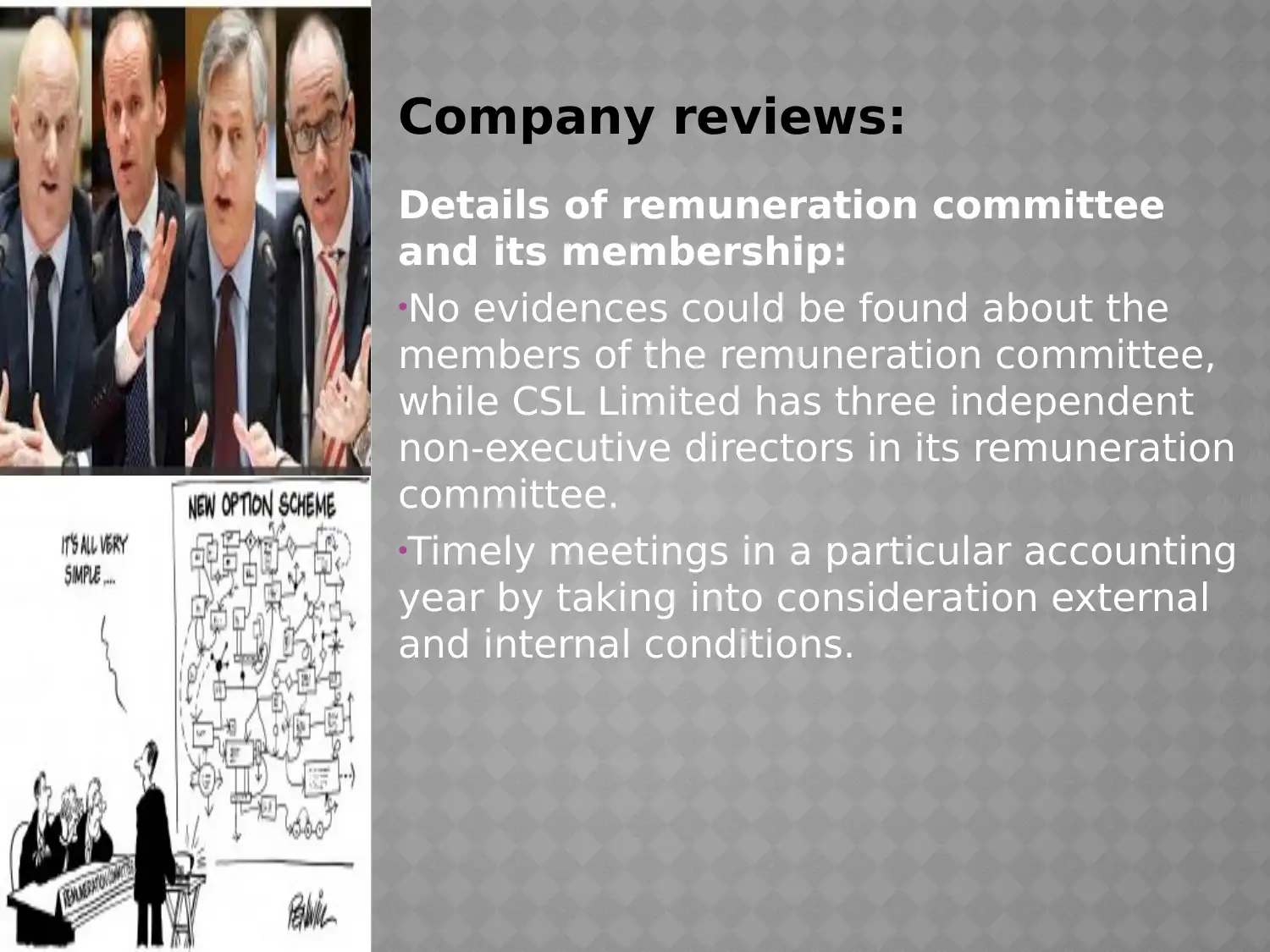
Company reviews:
Details of remuneration committee
and its membership:
•No evidences could be found about the
members of the remuneration committee,
while CSL Limited has three independent
non-executive directors in its remuneration
committee.
•Timely meetings in a particular accounting
year by taking into consideration external
and internal conditions.
Details of remuneration committee
and its membership:
•No evidences could be found about the
members of the remuneration committee,
while CSL Limited has three independent
non-executive directors in its remuneration
committee.
•Timely meetings in a particular accounting
year by taking into consideration external
and internal conditions.
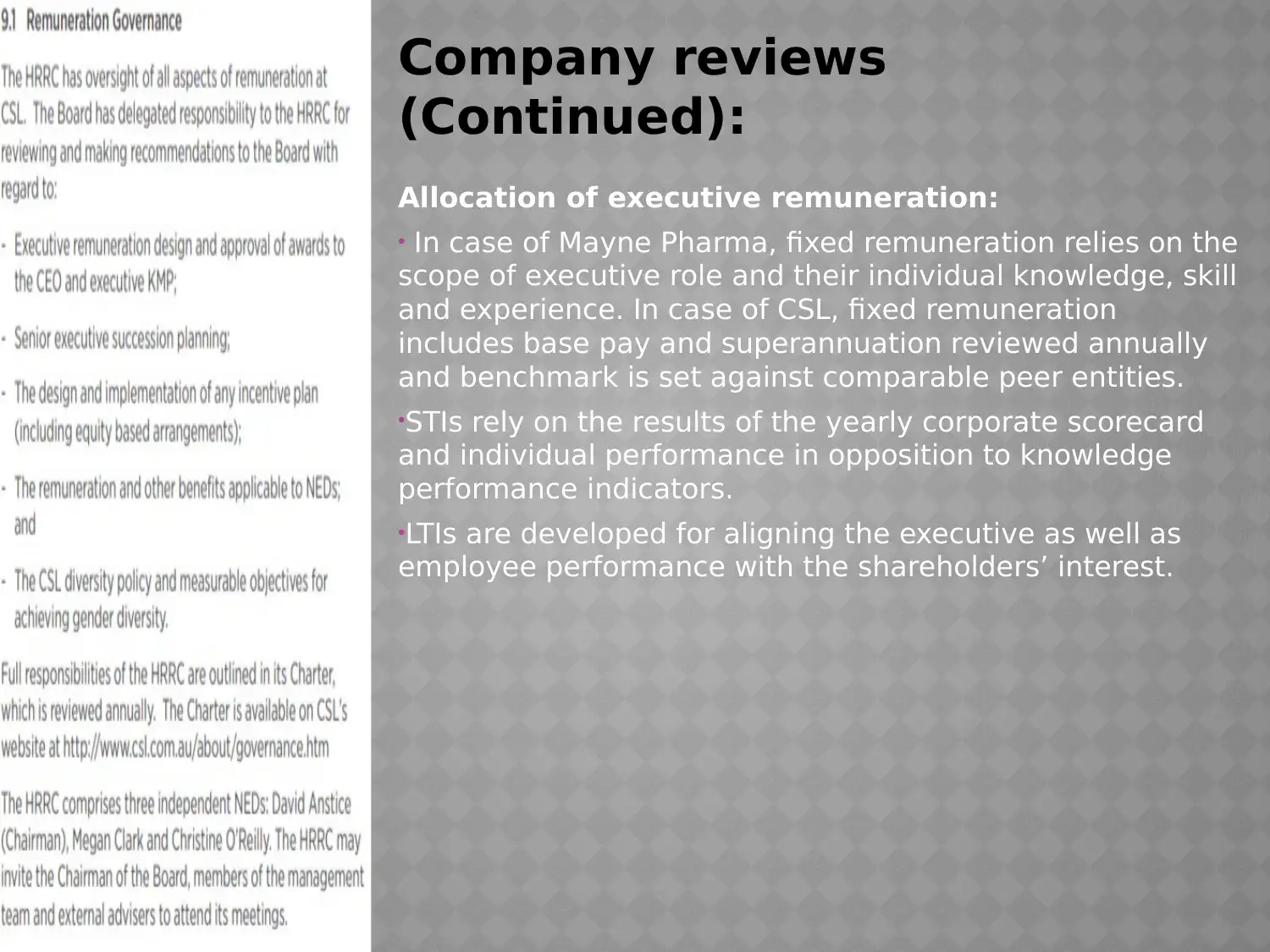
Company reviews
(Continued):
Allocation of executive remuneration:
• In case of Mayne Pharma, fixed remuneration relies on the
scope of executive role and their individual knowledge, skill
and experience. In case of CSL, fixed remuneration
includes base pay and superannuation reviewed annually
and benchmark is set against comparable peer entities.
•STIs rely on the results of the yearly corporate scorecard
and individual performance in opposition to knowledge
performance indicators.
•LTIs are developed for aligning the executive as well as
employee performance with the shareholders’ interest.
(Continued):
Allocation of executive remuneration:
• In case of Mayne Pharma, fixed remuneration relies on the
scope of executive role and their individual knowledge, skill
and experience. In case of CSL, fixed remuneration
includes base pay and superannuation reviewed annually
and benchmark is set against comparable peer entities.
•STIs rely on the results of the yearly corporate scorecard
and individual performance in opposition to knowledge
performance indicators.
•LTIs are developed for aligning the executive as well as
employee performance with the shareholders’ interest.
⊘ This is a preview!⊘
Do you want full access?
Subscribe today to unlock all pages.

Trusted by 1+ million students worldwide
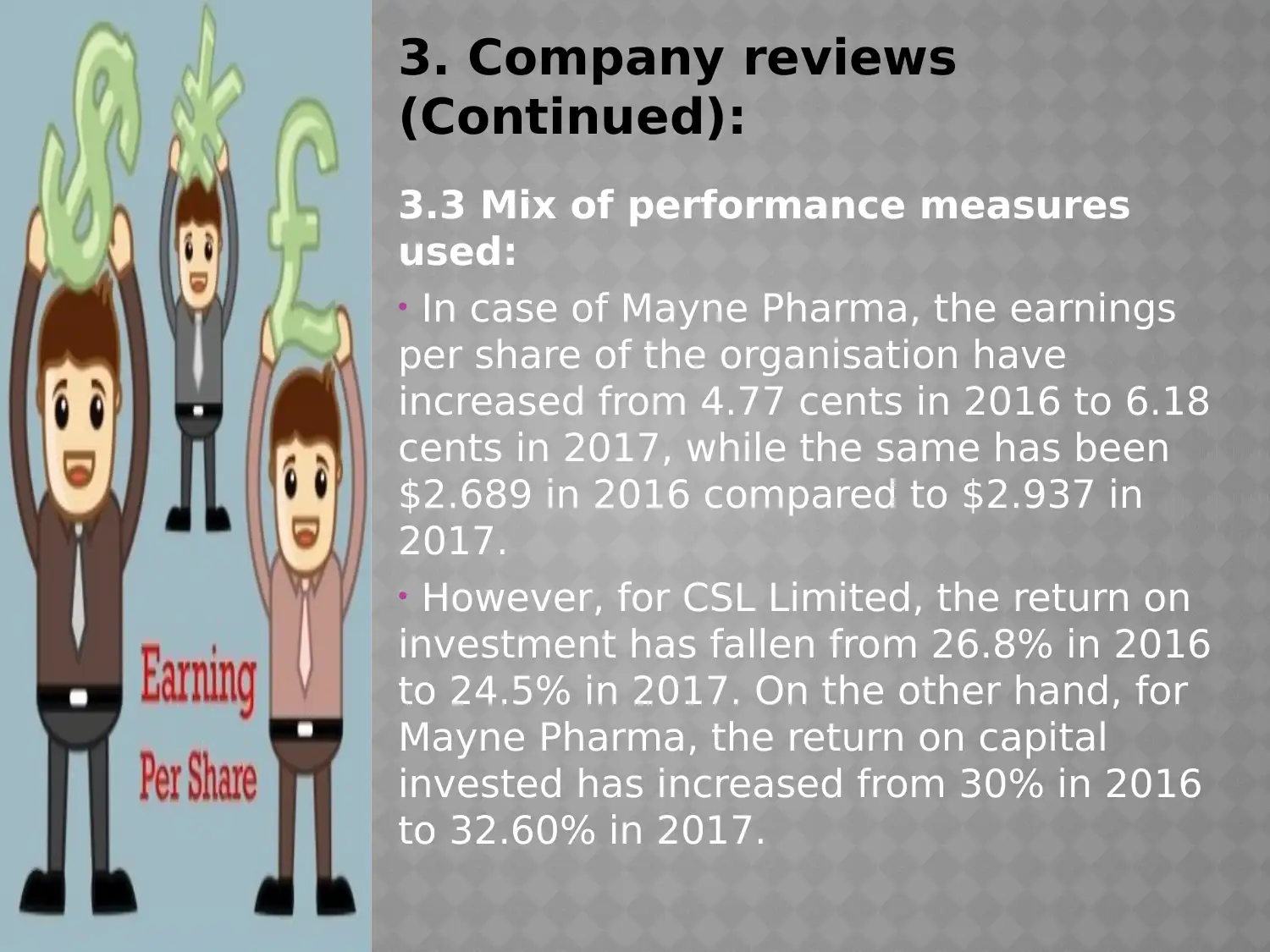
3. Company reviews
(Continued):
3.3 Mix of performance measures
used:
• In case of Mayne Pharma, the earnings
per share of the organisation have
increased from 4.77 cents in 2016 to 6.18
cents in 2017, while the same has been
$2.689 in 2016 compared to $2.937 in
2017.
• However, for CSL Limited, the return on
investment has fallen from 26.8% in 2016
to 24.5% in 2017. On the other hand, for
Mayne Pharma, the return on capital
invested has increased from 30% in 2016
to 32.60% in 2017.
(Continued):
3.3 Mix of performance measures
used:
• In case of Mayne Pharma, the earnings
per share of the organisation have
increased from 4.77 cents in 2016 to 6.18
cents in 2017, while the same has been
$2.689 in 2016 compared to $2.937 in
2017.
• However, for CSL Limited, the return on
investment has fallen from 26.8% in 2016
to 24.5% in 2017. On the other hand, for
Mayne Pharma, the return on capital
invested has increased from 30% in 2016
to 32.60% in 2017.
Paraphrase This Document
Need a fresh take? Get an instant paraphrase of this document with our AI Paraphraser
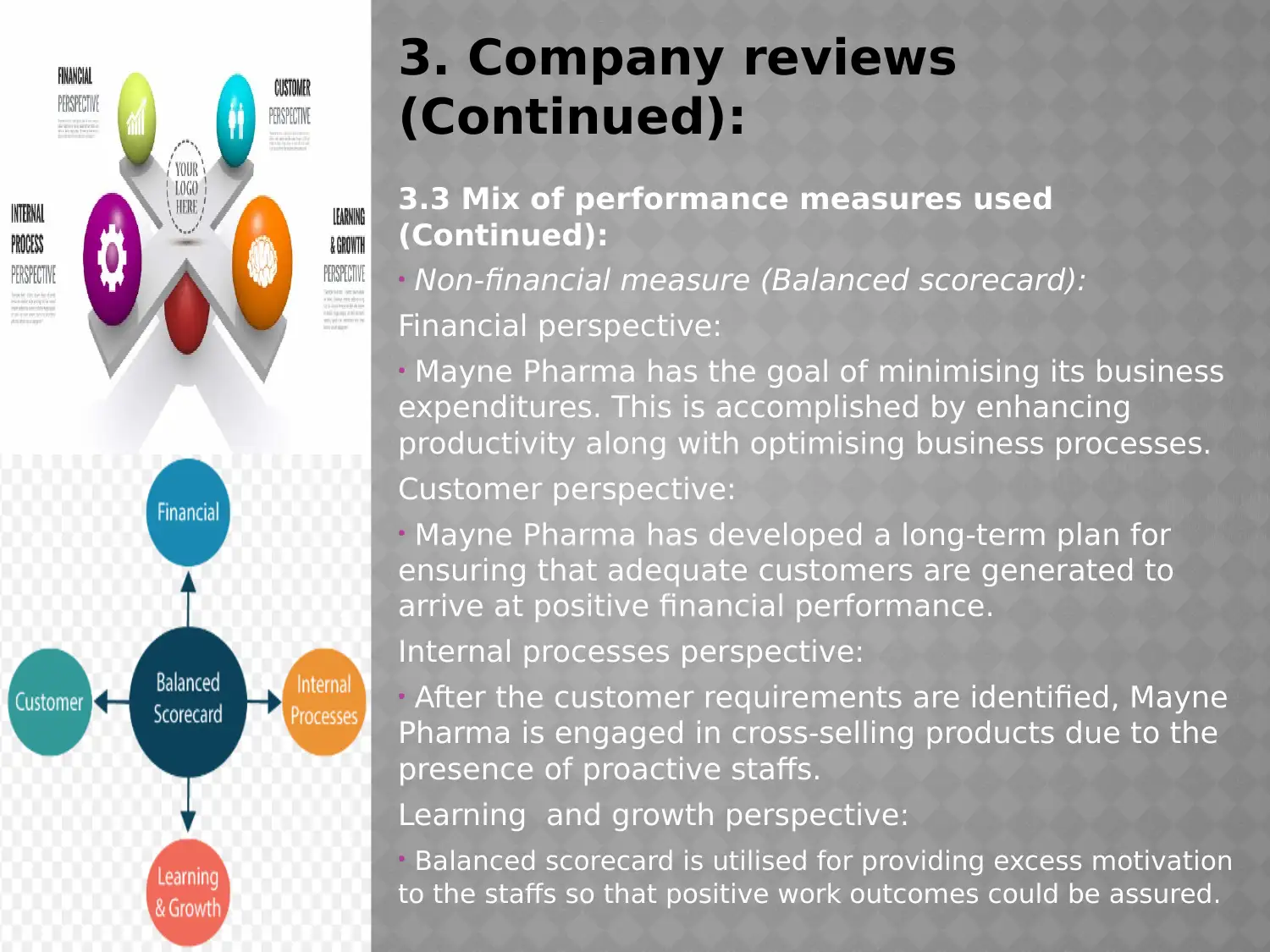
3. Company reviews
(Continued):
3.3 Mix of performance measures used
(Continued):
• Non-financial measure (Balanced scorecard):
Financial perspective:
• Mayne Pharma has the goal of minimising its business
expenditures. This is accomplished by enhancing
productivity along with optimising business processes.
Customer perspective:
• Mayne Pharma has developed a long-term plan for
ensuring that adequate customers are generated to
arrive at positive financial performance.
Internal processes perspective:
• After the customer requirements are identified, Mayne
Pharma is engaged in cross-selling products due to the
presence of proactive staffs.
Learning and growth perspective:
• Balanced scorecard is utilised for providing excess motivation
to the staffs so that positive work outcomes could be assured.
(Continued):
3.3 Mix of performance measures used
(Continued):
• Non-financial measure (Balanced scorecard):
Financial perspective:
• Mayne Pharma has the goal of minimising its business
expenditures. This is accomplished by enhancing
productivity along with optimising business processes.
Customer perspective:
• Mayne Pharma has developed a long-term plan for
ensuring that adequate customers are generated to
arrive at positive financial performance.
Internal processes perspective:
• After the customer requirements are identified, Mayne
Pharma is engaged in cross-selling products due to the
presence of proactive staffs.
Learning and growth perspective:
• Balanced scorecard is utilised for providing excess motivation
to the staffs so that positive work outcomes could be assured.
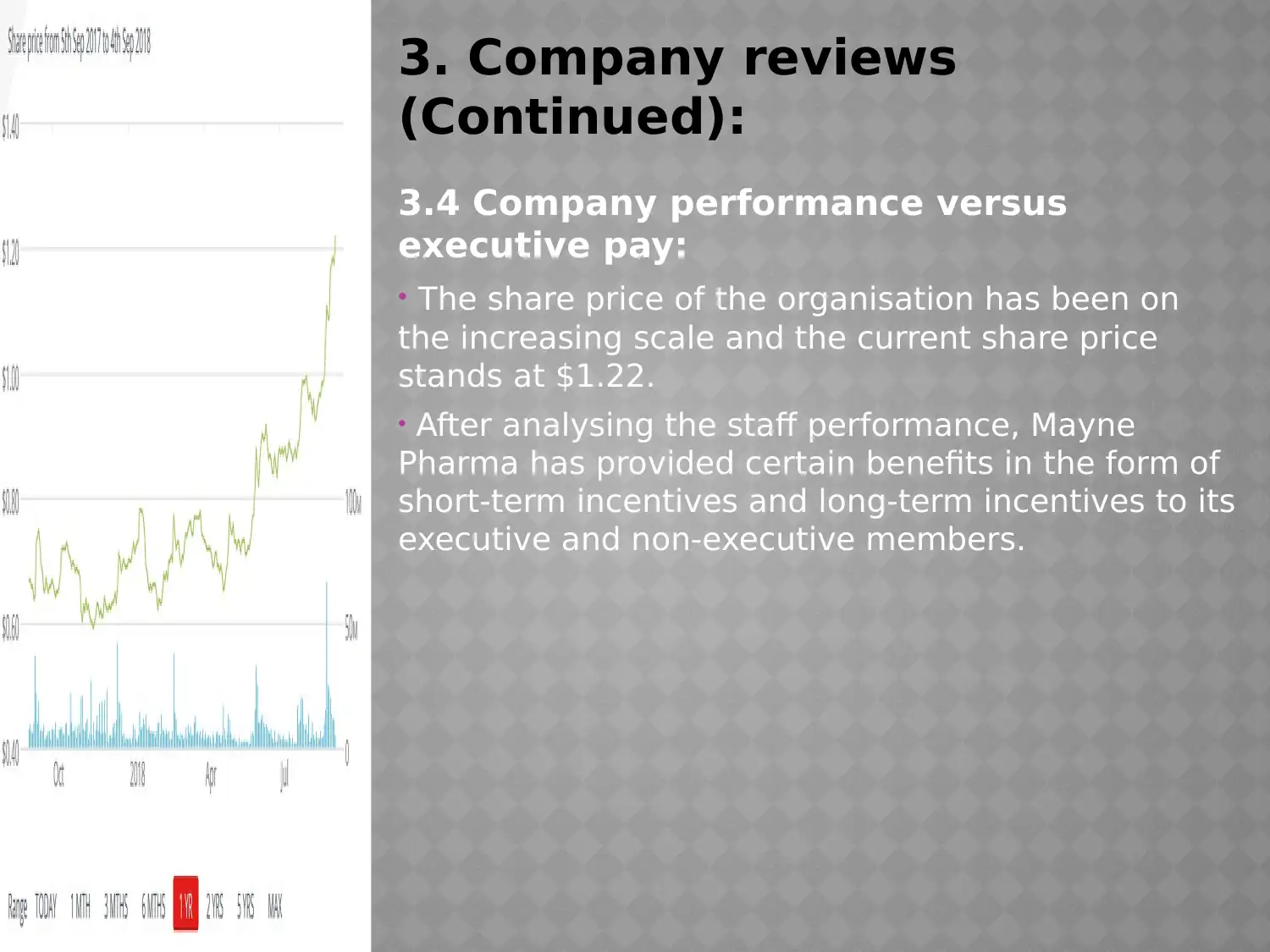
3. Company reviews
(Continued):
3.4 Company performance versus
executive pay:
• The share price of the organisation has been on
the increasing scale and the current share price
stands at $1.22.
• After analysing the staff performance, Mayne
Pharma has provided certain benefits in the form of
short-term incentives and long-term incentives to its
executive and non-executive members.
(Continued):
3.4 Company performance versus
executive pay:
• The share price of the organisation has been on
the increasing scale and the current share price
stands at $1.22.
• After analysing the staff performance, Mayne
Pharma has provided certain benefits in the form of
short-term incentives and long-term incentives to its
executive and non-executive members.
⊘ This is a preview!⊘
Do you want full access?
Subscribe today to unlock all pages.

Trusted by 1+ million students worldwide
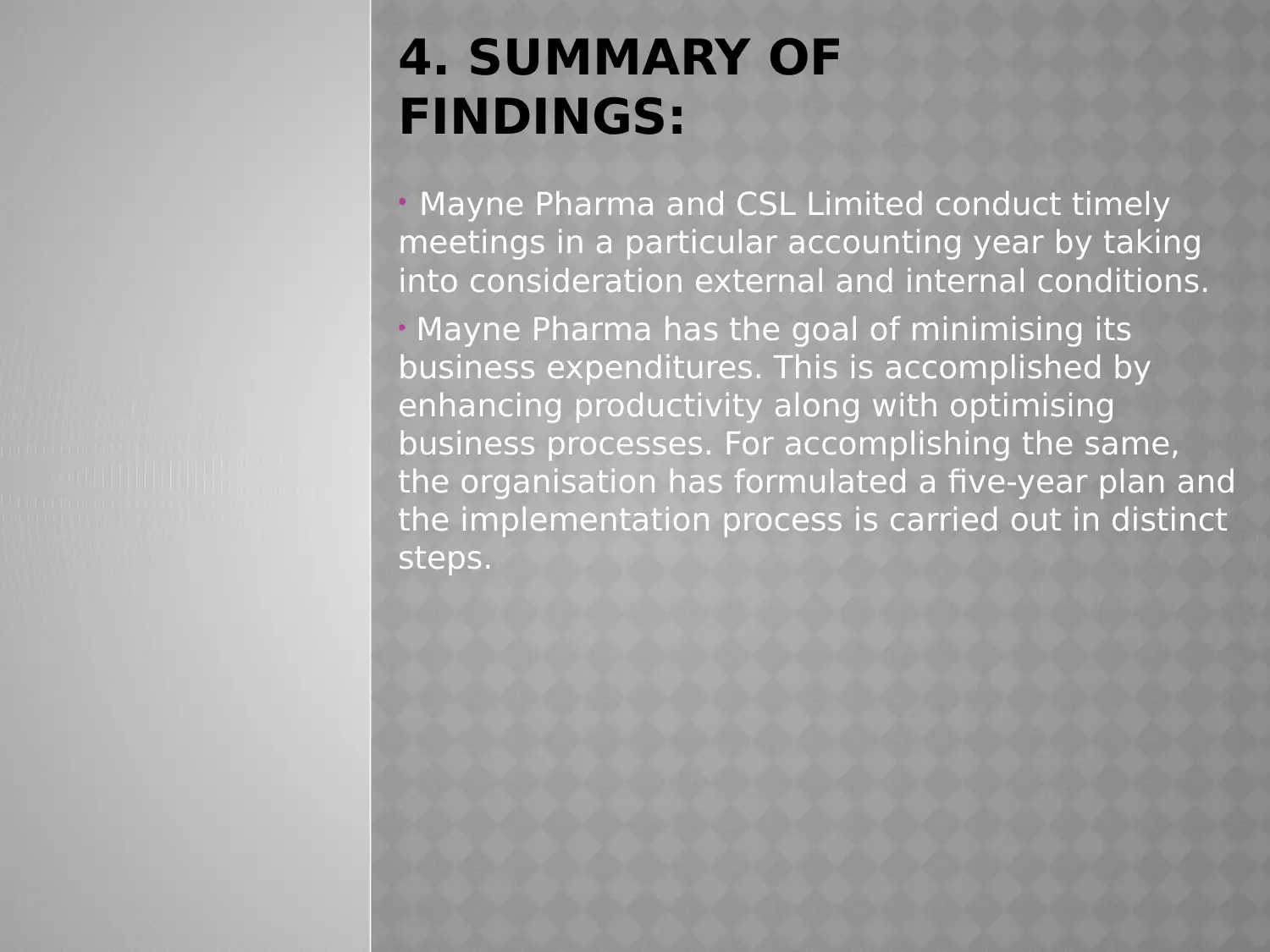
4. SUMMARY OF
FINDINGS:
• Mayne Pharma and CSL Limited conduct timely
meetings in a particular accounting year by taking
into consideration external and internal conditions.
• Mayne Pharma has the goal of minimising its
business expenditures. This is accomplished by
enhancing productivity along with optimising
business processes. For accomplishing the same,
the organisation has formulated a five-year plan and
the implementation process is carried out in distinct
steps.
FINDINGS:
• Mayne Pharma and CSL Limited conduct timely
meetings in a particular accounting year by taking
into consideration external and internal conditions.
• Mayne Pharma has the goal of minimising its
business expenditures. This is accomplished by
enhancing productivity along with optimising
business processes. For accomplishing the same,
the organisation has formulated a five-year plan and
the implementation process is carried out in distinct
steps.
Paraphrase This Document
Need a fresh take? Get an instant paraphrase of this document with our AI Paraphraser
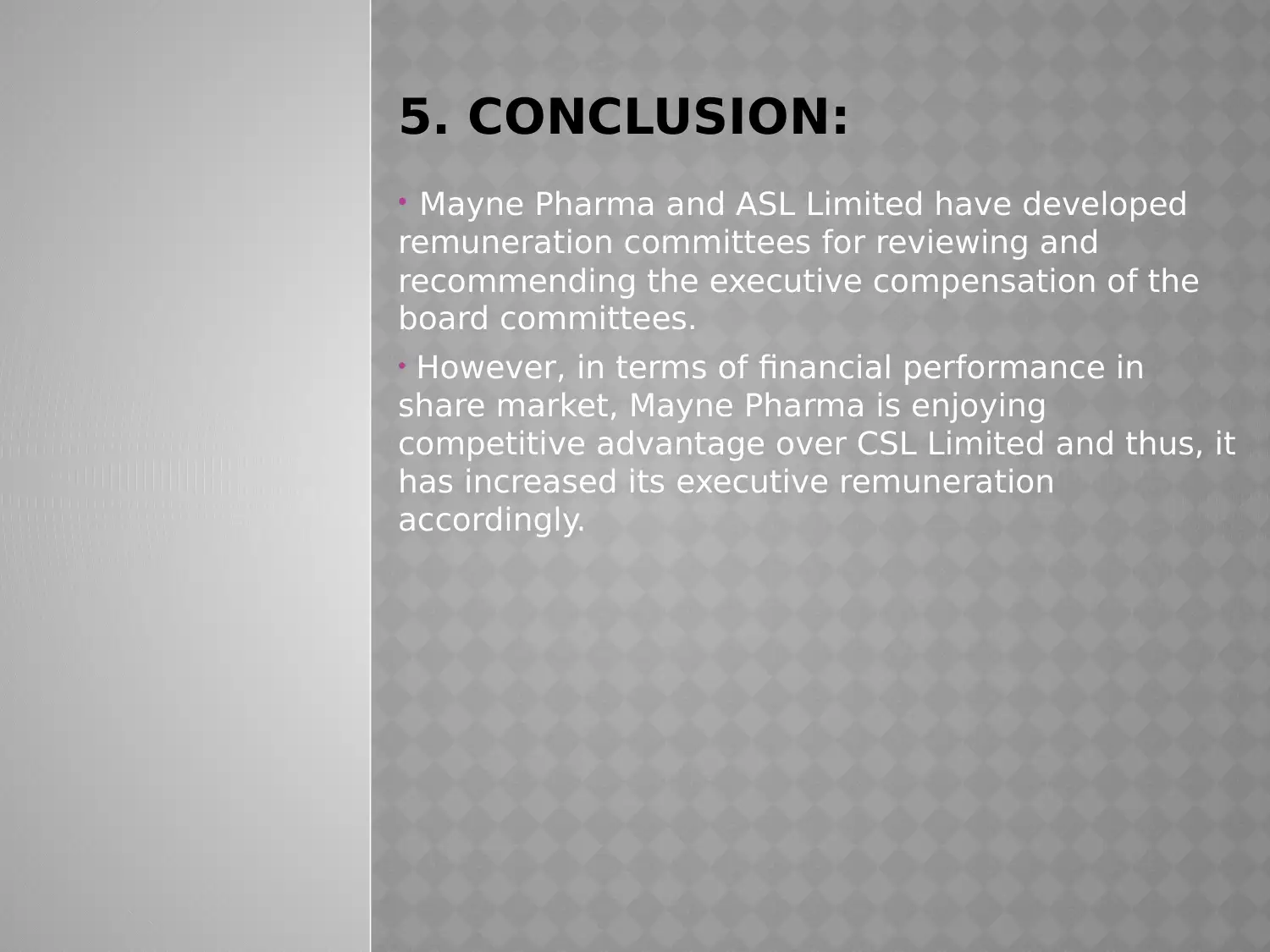
5. CONCLUSION:
• Mayne Pharma and ASL Limited have developed
remuneration committees for reviewing and
recommending the executive compensation of the
board committees.
• However, in terms of financial performance in
share market, Mayne Pharma is enjoying
competitive advantage over CSL Limited and thus, it
has increased its executive remuneration
accordingly.
• Mayne Pharma and ASL Limited have developed
remuneration committees for reviewing and
recommending the executive compensation of the
board committees.
• However, in terms of financial performance in
share market, Mayne Pharma is enjoying
competitive advantage over CSL Limited and thus, it
has increased its executive remuneration
accordingly.
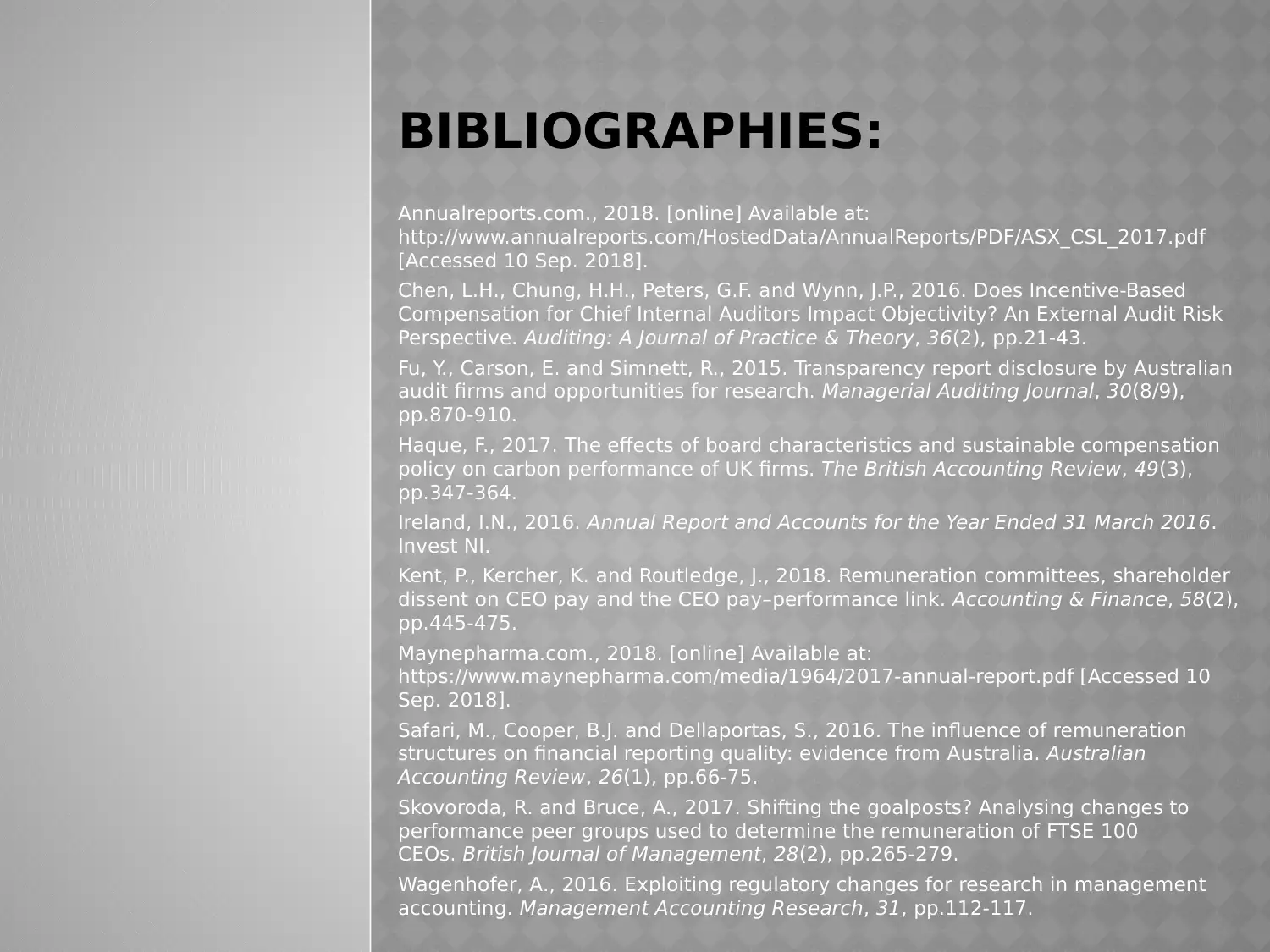
BIBLIOGRAPHIES:
Annualreports.com., 2018. [online] Available at:
http://www.annualreports.com/HostedData/AnnualReports/PDF/ASX_CSL_2017.pdf
[Accessed 10 Sep. 2018].
Chen, L.H., Chung, H.H., Peters, G.F. and Wynn, J.P., 2016. Does Incentive-Based
Compensation for Chief Internal Auditors Impact Objectivity? An External Audit Risk
Perspective. Auditing: A Journal of Practice & Theory, 36(2), pp.21-43.
Fu, Y., Carson, E. and Simnett, R., 2015. Transparency report disclosure by Australian
audit firms and opportunities for research. Managerial Auditing Journal, 30(8/9),
pp.870-910.
Haque, F., 2017. The effects of board characteristics and sustainable compensation
policy on carbon performance of UK firms. The British Accounting Review, 49(3),
pp.347-364.
Ireland, I.N., 2016. Annual Report and Accounts for the Year Ended 31 March 2016.
Invest NI.
Kent, P., Kercher, K. and Routledge, J., 2018. Remuneration committees, shareholder
dissent on CEO pay and the CEO pay–performance link. Accounting & Finance, 58(2),
pp.445-475.
Maynepharma.com., 2018. [online] Available at:
https://www.maynepharma.com/media/1964/2017-annual-report.pdf [Accessed 10
Sep. 2018].
Safari, M., Cooper, B.J. and Dellaportas, S., 2016. The influence of remuneration
structures on financial reporting quality: evidence from Australia. Australian
Accounting Review, 26(1), pp.66-75.
Skovoroda, R. and Bruce, A., 2017. Shifting the goalposts? Analysing changes to
performance peer groups used to determine the remuneration of FTSE 100
CEOs. British Journal of Management, 28(2), pp.265-279.
Wagenhofer, A., 2016. Exploiting regulatory changes for research in management
accounting. Management Accounting Research, 31, pp.112-117.
Annualreports.com., 2018. [online] Available at:
http://www.annualreports.com/HostedData/AnnualReports/PDF/ASX_CSL_2017.pdf
[Accessed 10 Sep. 2018].
Chen, L.H., Chung, H.H., Peters, G.F. and Wynn, J.P., 2016. Does Incentive-Based
Compensation for Chief Internal Auditors Impact Objectivity? An External Audit Risk
Perspective. Auditing: A Journal of Practice & Theory, 36(2), pp.21-43.
Fu, Y., Carson, E. and Simnett, R., 2015. Transparency report disclosure by Australian
audit firms and opportunities for research. Managerial Auditing Journal, 30(8/9),
pp.870-910.
Haque, F., 2017. The effects of board characteristics and sustainable compensation
policy on carbon performance of UK firms. The British Accounting Review, 49(3),
pp.347-364.
Ireland, I.N., 2016. Annual Report and Accounts for the Year Ended 31 March 2016.
Invest NI.
Kent, P., Kercher, K. and Routledge, J., 2018. Remuneration committees, shareholder
dissent on CEO pay and the CEO pay–performance link. Accounting & Finance, 58(2),
pp.445-475.
Maynepharma.com., 2018. [online] Available at:
https://www.maynepharma.com/media/1964/2017-annual-report.pdf [Accessed 10
Sep. 2018].
Safari, M., Cooper, B.J. and Dellaportas, S., 2016. The influence of remuneration
structures on financial reporting quality: evidence from Australia. Australian
Accounting Review, 26(1), pp.66-75.
Skovoroda, R. and Bruce, A., 2017. Shifting the goalposts? Analysing changes to
performance peer groups used to determine the remuneration of FTSE 100
CEOs. British Journal of Management, 28(2), pp.265-279.
Wagenhofer, A., 2016. Exploiting regulatory changes for research in management
accounting. Management Accounting Research, 31, pp.112-117.
⊘ This is a preview!⊘
Do you want full access?
Subscribe today to unlock all pages.

Trusted by 1+ million students worldwide

1 out of 10
Related Documents
Your All-in-One AI-Powered Toolkit for Academic Success.
+13062052269
info@desklib.com
Available 24*7 on WhatsApp / Email
![[object Object]](/_next/static/media/star-bottom.7253800d.svg)
Unlock your academic potential
Copyright © 2020–2025 A2Z Services. All Rights Reserved. Developed and managed by ZUCOL.




